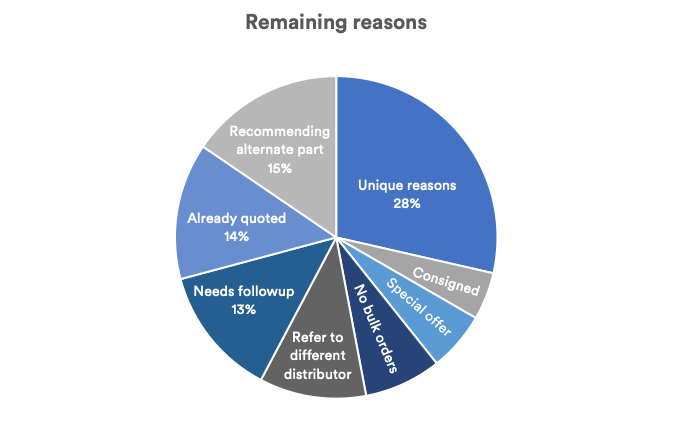

Dealing with hundreds of no-quotes per day has become a normal part of work. What can suppliers and buyers do to cut this number down?
Let’s examine a scenario. You’re searching for a specific replacement part to get your operations back on track. You scan the locator services and find the exact one you’re looking for, so you go ahead and submit an RFQ. Two days later, you get a response, or rather a non-response – a “no-quote.” And chances are, it’s bare, with no note or reason in sight, leaving you with the burning question – Why?
Two days later, you get a response, or rather a non-response – a “No-quote.”
To gain some insight why this happens, we analyzed an anonymized [1] sample of recent no-quotes returned to the buyer. Only about 5% of no-quotes are accompanied by a text description. While there are certainly limitations on how accurately such a small sample represents reality, hopefully these tidbits provide a glimpse into what's happening behind the scenes.
An obvious place to start this examination is the top reasons:

At the top of the list, “No stock” comes in as the most common explanation. As it turns out, there are over 50 common ways to say you don’t have stock, with the most popular being, go figure, “No stock”.
After that, the second most prominent reason is OEM restrictions on who can buy certain parts. For example, some manufacturers only allow operators (or shops directly contracted with operators) to purchase new parts. Any intermediaries receive a no-quote.
Next come two broad categories: condition or quantity mismatch between what the seller has and the buyer wants. Both condition (10%) and quantity (9%) issues can be traced to multiple causes. Sometimes, there are not enough cycles remaining on the part. Other times, the seller has a minimum order total and asks the buyer to buy more. Later in the post, we’ll examine the condition and quantity issues in more detail.
5% of no-quotes ask the buyer to make a price offer, adding another back-and-forth to the transaction. Another 5% provide no further information, for example: "Sorry, I have to no quote you."

There are a significant number of no-quotes returned because the buyer doesn’t include the target “cycles remaining” (CR) in their RFQ. As a buyer, including your target CR in the RFQ makes you 50% more likely to get a response!
That being said, it’s still possible for sellers to provide a buyer several options if target CR isn’t provided. Providing options materially increases the chance of a PO.

Of all quantity-related no-quotes, a majority (65%) come from a minimum quantity that the buyer doesn’t clear. Regardless of whether the buyer isn’t seeing the minimum or the seller isn’t listing it, a fair amount of time is used to submit and respond to these RFQs.
In fewer cases (7%), the seller has a minimum, but they also don’t have enough stock of the desired part for the buyer to meet that minimum. In this case, the buyer must add other parts to the purchase to reach that minimum.

The remainder of no-quotes -- the “Other” 25% shown in the first graph -- are split rather evenly among categories. Often, these are situations where the request calls for some kind of special processing or bespoke solution.
For many, no-quoting is a non-issue. After all, dealing with hundreds of no-quotes per day has become a normal part of work. However, it takes both the seller and buyer significant time to send and receive all these messages. Perhaps there are some lessons to be taken away!
Sometimes, a no-quote is unavoidable. However, doing a few simple things can drive them down and allow you to spend more time selling!
[1] Prior to analysis, a sample set of 20,000 recent no-quotes was de-identified and anonymized, removing PII. The research dataset was analyzed for keywords by automated means, and then deleted.